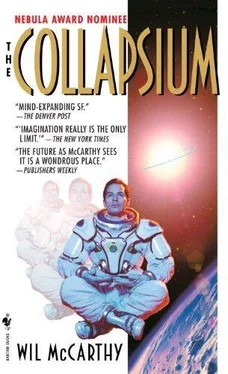Supraluminal(adj) Exceeding the standard vacuum speed of light.
Telegravitlc(adj) Involving gravity projectors.
Telerobotlc(adj) Controlled from afar. Rarely applied except to machines.
Terraform ash(n) A wellstone substance of shifting composition, intended to provoke pseudochemical reactions in a planetary atmosphere. Also known as “wellstone flake.”
Tonga(n) Former Polynesian kingdom consisting of the Tongatapu, Ha’apai, and Vava’u archipelagos, and scattered islands occasionally including parts of Fiji. Tonga was the only Polynesian nation never to be conquered or colonized by a foreign power, and was the last human monarchy prior to establishment of the Queendom of Sol.
Tongatapu(n) The largest and most populous island of Tonga; home to its traditional capital at Nuku’alofa.
True Vacuum(n) A hypothetical state of vacuum in which all zpf wavelenths are excluded or suppressed.
Turbulent(adj) The mathematical state between laminar and hypothetical “random” activity. Any condition in which the motion of a point varies rapidly.
Upsystem(adv) Away from the sun.
Vacougel(n) Any fibrous or spongy substance consisting mostly of empty space.
Vacuum(n, adj) The default state of spacetime in the absence of charge. On stochastic average, half the available photon states of a standard vacuum are filled.
Wellstone(n) A substance consisting of fine, semiconductive fibers alternating with quantum dots, capable of emulating a broad range of natural, artificial, and hypothetical materials. See Appendix A: Wellstone, pg. 363.
Wellwood(n) An emulation of lignous cellulose (wood), often employed as the default state of wellstone devices.
Zero-point field (zpf)(n) Technical name for the isotropic, Lorentz-invariant energy field of the vacuum’s half-filled photon states. When interacting with point charges, the zero-point field gives rise to fourth-dimensional spacetime curvature which creates the illusion of mass, gravity, and inertia in the three-dimensional universe.
Zitterbewegung(n) The “trembling motion” of charged particles interacting with the zero-point field. Zitterbewegung creates the secondary fields or spacetime curvatures associated with gravity and inertia.
Appendix C
Technical Notes
Many readers will be unfamiliar with the physical/cosmological theories on which this story is based, and may find the apparent contradictions jarring. Research into zero-point fields and forces has produced a growing and quite impressive body of literature that, as of this writing, has received little attention outside the astrophysics community. The situation vis-a-vis “quantum-dot” technology is somewhat better, though the implications may still sound a bit magical to some.
The gravitational theories that gave birth to this book are some of the most fascinating and cutting-edge science being performed today. As far as I know, “collapsium” is my own invention, although I’ve since encountered the word in different context in a couple of places. For helping deduce and refine the mechanism by which collapsium could actually work, I’m deeply indebted to Drs. Richard M. Powers, the Right Reverend Gary E. Snyder, Bjorn Ostman, Boris Gudiken, Arthur C. Clarke, and especially Bernhard Haisch of the Lockheed Martin Solar and Astrophysics Laboratory in Palo Alto.
For those wanting to learn more about this body of work, three of Haisch’s papers on the subject, coauthored with Drs. A. Rueda and H. E. Puthoff, include “Physics of the Zero-Point Field: Implications for Inertia, Gravitation and Mass”
(Speculations in Science and Technology , 1996), “Inertia as a Zero-Point Lorentz Force” (Phys. Review A , Feb 1994), and the wonderfully for-dummies “Beyond E=mc 2” (The Sciences , Nov/Dec 1994), which is available on-line at http://www. jse.com/haisch/sciences.html).
In discussions of charge-derived gravitation, the most common question is usually, “Why do neutrons have mass?” The answer is simply that neutrons are composed of quarks whose charges cancel out. The quarks themselves are charged, and therefore exhibit the zitterbewegung motions that give rise to gravity and inertia. The neutron’s “mass” is therefore a derived, rather than fundamental, property.
A more difficult question to answer is, “Why does gravity affect photons and neutrinos?” Current theory has a hard time explaining this, but I believe the short answer is probably “because charge warps spacetime.” For a detailed explanation of this concept, I’ll refer you to Steven C. Bell of Lockheed Martin Astronautics, whose “On Quantized Electronic Schwarzchild and Kerr Relativistic Models for the Spherical Orbitals of Hydrogen” can be found online at http://www.mindspring.com/~sb635/pap4.htm.
A formal unification of these theories has yet to be completed; while Bell makes a compelling case for charge as a general-relativistic influence on spacetime curvature, no one has yet approached it as the only such influence. Still, I think at least one road is clearly leading in that direction.
As for collapsium itself, the “Haisch effect” of Appendix A has never been tested in the laboratory. I doubt the necessary technology will exist for at least the next several decades. Nonetheless, assuming the effect is real, it should be possible to collapse a proton into a black hole by increasing its apparent mass. Collapse occurs when the Schwarzchild radius of the increased mass equals or exceeds the proton’s radius:
R s=1.5E–15m
R s= 2yJC 2 = (2) (6.672E-11) (M)/(3.0E+08) 2.-.M=8.768Ellkg
Hence the mass of one billion metric tons for the “neubles” that feed the process.
Gravitational effects of such a tiny hypermass are indicated by the following equations:
Gravity at 6 cm Range:
g R= (JL/R 2= (66.72) (0.06) 2= 18533.3 m/sec 2(approximately 1900 times Earth surface gravity, ge)
Gravity Gradient : og R/SR = -2fjL/R 3= (-2) (66.72)/(0.06) 3=
-6.18E+05sec 2or, 8g R/8R = -6.3E+04 ge/m (changes by 630 Earth gravities in first centimeter) Meanwhile, only four meters away…
Gravity at 4.06 in Range:
g R= (i/R 2= (66.72)/(0.06+4.0) 2= 4.23 m/sec 2(approximately 0.4 times Earth surface gravity, ge)
Gravity Gradient : ogR/SR = -2fi/R ?= (-2) (66.72) /(0.06+4.0) 3= –1.99 sec –2
or, 8 R/8R = –0.203 ge/m (changes by 0.2 Earth gravities in first meter)
So it’s certainly nothing you’d want to be standing very close to. For anyone who’s read my 1995 novel Flies from the Amber or who is otherwise familiar with the spacetime effects of a hypermass, the question of gravitational time dilation naturally occurs. Sorry, the math will disappoint you:
•y = 1 -2|i / (RC 2) = 1 -(2) (66.72) / (0.06) (3.0E+08) 2•y = 2.47E-14
In other words, even at the lethal 6 cm range, time passes only 0.0000000000025% more slowly than in the outside universe. So for human beings, collapsium does not constitute a forward-only time machine unless, like Marlon’s cage defin , it’s moving at relativistic velocity. C‘ est la vie .
As for the obvious, “Why don’t the collapsium’s black holes fall into each other?” the answer lies in sympathetic vibrations. This is the same principle that lets “stealth” helicopters fly silently: the sounds produced by the engine and blades are measured, and a “negative” of the wave pattern—a set of equivalent sound waves 180 degrees out of phase—is produced to cancel it. If gravity is truly the result of vibration, an equivalent damping mechanism is quite plausible.
Читать дальше












